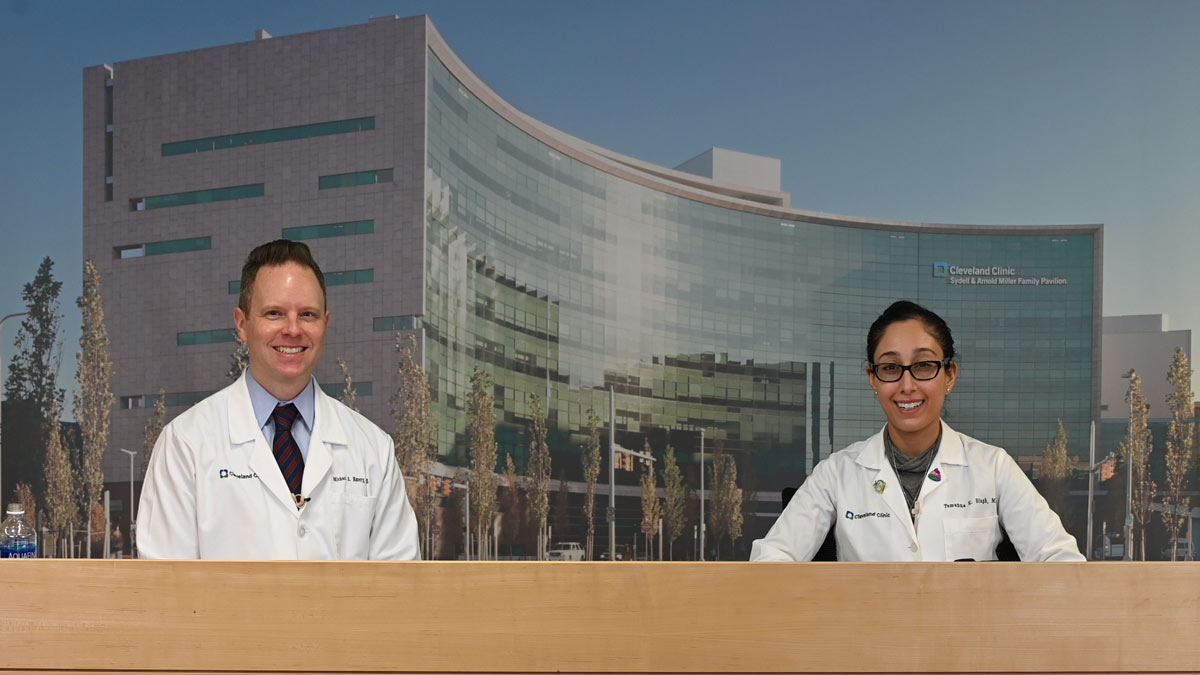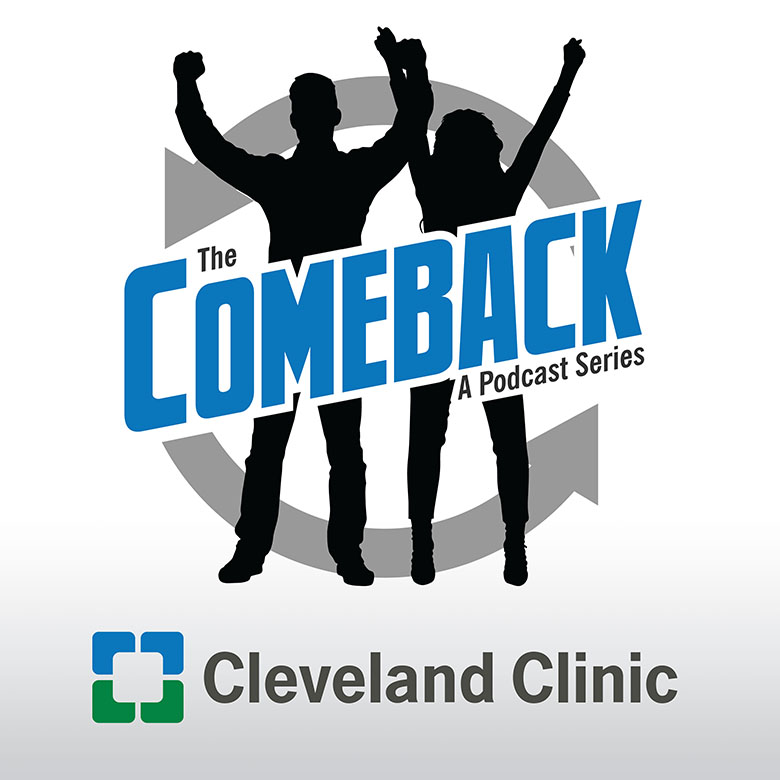What Happens After Someone Experiences Sudden Cardiac Arrest While Playing Sports?

Sudden cardiac arrest occurs when the heart stops beating or is not beating sufficiently to maintain adequate blood flow and life. This can happen to anyone. Dr. Michael Emery and Dr. Tamana Singh, Co-Directors of the Sports Cardiology Center, talk about what happens to an athlete who experiences sudden cardiac arrest and everything that happens after.
Learn more about the Sports Cardiology Center at Cleveland Clinic
Learn more about Sudden Cardiac Arrest
Subscribe: Apple Podcasts | Podcast Addict | Buzzsprout | Spotify
What Happens After Someone Experiences Sudden Cardiac Arrest While Playing Sports?
Podcast Transcript
Announcer:
Welcome to Love Your Heart, brought to you by Cleveland Clinic's Sydell and Arnold Miller Family Heart, Vascular and Thoracic Institute. These podcasts will help you learn more about your heart, thoracic and vascular systems, ways to stay healthy and information about diseases and treatment options. Enjoy.
Michael Emery, MD:
Hi, I'm Dr. Michael Emery. I'm co-director of the Sports Cardiology Center at the Cleveland Clinic.
Tamana Singh, MD:
And I'm Dr. Tamana Singh. I'm also co-director of our Sports Cardiology Center here.
Michael Emery, MD:
We wanted to take some time today to discuss sudden cardiac arrests and sudden cardiac death in athletes. But first, Dr. Singh, I want to start by having you tell us the difference between sudden cardiac arrest or cardiac arrest and a heart attack.
Tamana Singh, MD:
Yeah, that's an excellent question. So cardiac arrest is when the heart actually goes into an abnormal rhythm originating from the bottom chambers of the heart that can actually cause death, versus a heart attack where there's a part of the heart muscle that's not getting adequate blood supply or oxygen supply at a particular point of stress, or even when someone is just sitting and watching TV. So one's an abnormal heart rhythm that can cause death and the other one is a lack of blood flow and oxygen delivery to part of the heart muscle that could then also cause sometimes some abnormal heart rhythms and death.
Michael Emery, MD:
So off that, we see media reports and a lot of public media attention when an athlete suffers sudden cardiac arrest. How do we know when an athlete arrests? What does it look like?
Tamana Singh, MD:
Sure. I mean that's a great question. I think just to preface that, cardiac arrest, even outside of the athletic sphere, is actually, I don't want to say common, but not unheard of. Out-of-hospital arrests exceed about 350,000 a year. And so when we talk about athletes specifically, that number is much, much, much lower. And our response to both athletes and non-athletes is quite similar. I think the biggest difference with athletes is there's usually a plan that the team and the people involved with that particular sport are aware of to help make sure that timely management of that athlete occurs. So when someone, an athlete, goes down on the field or on the court or their place of sport location, there is an immediate attempt to do what we call cardiopulmonary resuscitation.
And the easiest way to start that is with chest compressions and breaths. And so, once we can actually begin that initiation of trying to deliver oxygen to a lot of the vital organs, predominantly the brain, and then we have a whole host of other things that can happen. We have our medical team come to the athlete. They can also help with CPR or cardiopulmonary resuscitation. Sometimes if the athlete's not breathing, it may require assistance in helping them breathe with a tube, a breathing tube. And then the next course of action is really to determine what caused this player to go down? And one of the biggest things and biggest tools we have to help with this is an automated external defibrillator.
So it's an actual device that comes in a pouch and you open up the pouch, you turn the device on, it tells you everything you need to do. We put pads on the athlete and this device can tell us whether or not an abnormal heart rhythm is causing that person or caused that person to go down and arrest. And if it was a heart rhythm problem, this device can actually deliver an electrical shock that attempts to reset the heart into a normal rhythm. And the most important part of that is that a normal rhythm means you can get blood flow and oxygen delivery to all parts of your body, and hopefully that person can regain consciousness and alertness.
Michael Emery, MD:
And I think one of the important features when we talk sporting is an emergency action plan, which CPR and a defibrillator are part of an emergency action plan. So any organized team sport or organized individual sport in a structured setting should have some form of an emergency action plan that's well thought out, well-rehearsed for what to do if an athlete goes down. CPR and the AED should be onsite, readily available and functional because they're lifesaving. I think then the benefits of knowing this from a general public standpoint is anyone can do hands-only CPR, activate 9-1-1 and get an AED. There's no need to be afraid of a defibrillator. You as a bystander don't have to decide whether I need to shock this patient. Your only decision of duty is to put it on and turn it on and the system will make its own decision. Don't be afraid of the AED, don't be afraid to call 9-1-1, don't be afraid to start CPR because you as a bystander can save someone's life.
Tamana Singh, MD:
That's an excellent point, Dr. Emery. And I think to curtail off of that, even if you're unsure of the cause of why someone went down, whether it be an athlete or a non-athlete, I always say just assume that it could be a heart problem because we have these tools that can help us determine if it really isn't. Every place predominantly like hospitals and gyms where you might work out, airports also have AEDs. And the cool thing about our airport here in Cleveland is there's actually little stations where you can learn how to do CPR and adequate chest compressions. So feel empowered to learn these things and there's a lot of tools online. You can always ask your medical providers as well if you need help just to get comfortable with how to resuscitate an individual. A lot of arrests don't happen on the field like we mentioned, they happen outside in public spaces and nursing homes. So if you can be that person who feels comfortable getting help and providing help, you can really save a life.
Michael Emery, MD:
So speaking specifically about sudden cardiac arrests in athletes, how common is it? How many times does this tend to happen in the U.S. on a yearly basis?
Tamana Singh, MD:
So with respect to athletes alone, it typically varies depending upon gender as well as race. But overall, the general statistic we tend to quote is one in about 40 to 80,000 annually.
Michael Emery, MD:
So that's about 100 a year.
Tamana Singh, MD:
Mm-hmm.
Michael Emery, MD:
So they are rare, thankfully, but they do occur. So if one does occur, we talked about the emergency action plan and how vital that is into the link of survival. And now the next step, you've been resuscitated from your sudden cardiac arrest, what can be expected from the process afterwards to try to figure out what caused it?
Tamana Singh, MD:
So it really depends on whether or not the athlete has regained consciousness or not. So regaining consciousness and not, I think overarching the diagnostic strategy is very similar, but I'll talk about the unconscious athlete first. We typically bring them to the hospital and we have them go to the intensive care unit. Oftentimes, we will elicit what we call a hypothermia protocol or a cooling protocol in the attempt to put that athlete in a "hibernation," state to help decrease the demands that the body may have to oxygenate and hopefully improve neurologic function. Once that unconscious athlete is cooled and rewarmed and hopefully regains alertness, we really start to do cardiac testing and that's where we can bring those two pools of individuals together.
We will do testing including imaging of the heart, looking at its structure and function. We'll look at images of the vessels that supply the heart with its oxygenation, so the coronary arteries. And then we'll have to look to see whether or not there's electrical abnormality. So problems with the heart's electricity that could have precipitated the arrest. So those are the three big camps, heart muscle, structure and function, the "plumbing," or the coronary arteries and then the electricity, the electrical circuit of the heart. And then after that, we start to dig at other types of causes of arrests that may not fall within those confines.
Michael Emery, MD:
After an athlete has been resuscitated and brought to the hospital and shown some evidence of recovery, that's when we'll take a deep dive and try to figure out the etiology of these things. I'll say in most young athletes, it's probably, I say probably on purpose, some underlying genetic condition they didn't know they had. Occasionally, it can be an acquired condition, but there's also the chance that we can't figure it out. There are instances where people have clear cardiac arrests and despite all of our technology and testing, we still can't figure out the etiology. We can't and if it's not reversible, then we have to talk about what the next steps are. And those are very individualized discussions that may involve a defibrillator be implanted and then return to play discussions if they're appropriate. But most importantly, I think we want to drive home from this discussion today is the emergency action plan and how vital that prompt recognition, prompt CPR and prompt defibrillation are important to the chain of survival for anyone that has a sudden cardiac arrest, let alone an athlete. Anything else you'd like to add, Dr. Singh?
Tamana Singh, MD:
I think sometimes we may not put as much importance on the impact seeing an arrest or being involved in an arrest may have on just our psychological wellbeing. So it's really important after these events even as a team talking about what had happened, what went well, what may not have gone well. And if you are the person who has experienced an arrest or you're someone who helped with an arrest or witnessed the arrest happening, please talk to someone. Talk to people who can provide support because especially if you're not working within the medical field, it definitely can be something that is quite foreign and can be challenging to conceptualize and process through. There's definitely individuals who have developed a little bit of post-traumatic stress after events and we want to recognize that mental health during these particular events and even after, it's really important.
Michael Emery, MD:
Dr. Singh, I'd like to thank you for your time.
Announcer:
Thank you for listening. We hope you enjoyed the podcast. We welcome your comments and feedback. Please contact us at heart@ccf.org. Like what you heard? Subscribe wherever you get your podcasts or listen at clevelandclinic.org/loveyourheartpodcast.

Love Your Heart
A Cleveland Clinic podcast to help you learn more about heart and vascular disease and conditions affecting your chest. We explore prevention, diagnostic tests, medical and surgical treatments, new innovations and more.


